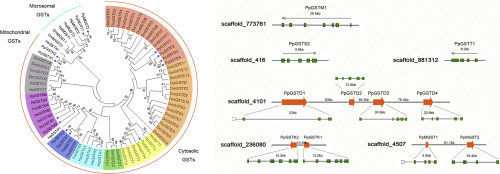当前位置:
X-MOL 学术
›
Comp. Biochem. Physiol. D Genom. Proteom.
›
论文详情
Our official English website, www.x-mol.net, welcomes your
feedback! (Note: you will need to create a separate account there.)
Identification, genomic organization and expression pattern of glutathione transferase in Pardosa pseudoannulata.
Comparative Biochemistry and Physiology D: Genomics & Proteomics ( IF 2.2 ) Pub Date : 2019-09-12 , DOI: 10.1016/j.cbd.2019.100626 Wei Liu 1 , Jiahua Tian 1 , Nannan Hou 1 , Na Yu 1 , Yixi Zhang 1 , Zewen Liu 1
Comparative Biochemistry and Physiology D: Genomics & Proteomics ( IF 2.2 ) Pub Date : 2019-09-12 , DOI: 10.1016/j.cbd.2019.100626 Wei Liu 1 , Jiahua Tian 1 , Nannan Hou 1 , Na Yu 1 , Yixi Zhang 1 , Zewen Liu 1
Affiliation

|
The pond wolf spider, Pardosa pseudoannulata, is one of the dominant natural enemies in farmlands and plays important roles in controlling a range of insect pests. The spider is less sensitive to many insecticides than the target pests such as the brown planthopper, Nilaparvata lugens. The different sensitivity to a certain insecticide between species is mostly attributed to the differences in both molecular targets and detoxification enzymes. As one of the most important detoxification enzymes, glutathione transferases (GSTs) play a key role as phase II enzyme in the enzymic detoxification in organisms. Until now, there are few studies on spiders' GSTs, limiting the understanding of insecticide selectivity between insect pests and natural enemy spiders. In this study, based on the transcriptome and genome sequencing of P. pseudoannulata, thirteen full-length transcripts encoding GSTs were identified and analyzed. Interestingly, Delta family, which is thought to be specific to the Insecta, was identified in P. pseudoannulata. Further, vertebrate/mammalian-specific Mu family was also identified in P. pseudoannulata. The mRNA expression levels of cytosolic GSTs in different tissues were determined, and most GST genes were abundant in the gut and the fat body. To investigate GST candidates involving in insecticide detoxification, the mRNA levels of cytosolic GSTs were tested after spiders' exposure to either imidacloprid or deltamethrin. The results showed that PpGSTD3 and PpGSTT1 responded to at least one of these two insecticides. The present study helped understand the function of GSTs in P. pseudoannulata and enriched the genetic information of natural enemy spiders.
中文翻译:

拟南芥中谷胱甘肽转移酶的鉴定,基因组组织和表达模式
池塘狼蛛,Pardosa pseudoannulata,是农田的主要天敌之一,在控制多种害虫中起着重要作用。蜘蛛对许多杀虫剂的敏感性不如目标害虫(例如褐飞虱,褐飞虱)敏感。物种之间对某种杀虫剂的不同敏感性主要归因于分子靶标和解毒酶的差异。谷胱甘肽转移酶(GST)作为最重要的排毒酶之一,在生物体内的酶排毒过程中作为II期酶发挥着关键作用。迄今为止,关于蜘蛛的GST的研究很少,这限制了对害虫和天敌蜘蛛之间杀虫剂选择性的了解。在这项研究中,基于假单胞菌的转录组和基因组测序,鉴定和分析了十三种编码GST的全长转录物。有趣的是,在P. pseudoannulata中发现了被认为是特定于Insecta的Delta家族。此外,在假单胞菌中也鉴定出脊椎动物/哺乳动物特异性的Mu家族。测定了不同组织中胞质GST的mRNA表达水平,大多数GST基因在肠道和脂肪体中丰富。为了研究涉及杀虫剂解毒的GST候选物,在蜘蛛暴露于吡虫啉或溴氰菊酯后测试了胞质GST的mRNA水平。结果表明,PpGSTD3和PpGSTT1对这两种杀虫剂中的至少一种有反应。本研究有助于了解GSTs在假单胞菌中的功能,并丰富了天敌蜘蛛的遗传信息。
更新日期:2019-09-12
中文翻译:

拟南芥中谷胱甘肽转移酶的鉴定,基因组组织和表达模式
池塘狼蛛,Pardosa pseudoannulata,是农田的主要天敌之一,在控制多种害虫中起着重要作用。蜘蛛对许多杀虫剂的敏感性不如目标害虫(例如褐飞虱,褐飞虱)敏感。物种之间对某种杀虫剂的不同敏感性主要归因于分子靶标和解毒酶的差异。谷胱甘肽转移酶(GST)作为最重要的排毒酶之一,在生物体内的酶排毒过程中作为II期酶发挥着关键作用。迄今为止,关于蜘蛛的GST的研究很少,这限制了对害虫和天敌蜘蛛之间杀虫剂选择性的了解。在这项研究中,基于假单胞菌的转录组和基因组测序,鉴定和分析了十三种编码GST的全长转录物。有趣的是,在P. pseudoannulata中发现了被认为是特定于Insecta的Delta家族。此外,在假单胞菌中也鉴定出脊椎动物/哺乳动物特异性的Mu家族。测定了不同组织中胞质GST的mRNA表达水平,大多数GST基因在肠道和脂肪体中丰富。为了研究涉及杀虫剂解毒的GST候选物,在蜘蛛暴露于吡虫啉或溴氰菊酯后测试了胞质GST的mRNA水平。结果表明,PpGSTD3和PpGSTT1对这两种杀虫剂中的至少一种有反应。本研究有助于了解GSTs在假单胞菌中的功能,并丰富了天敌蜘蛛的遗传信息。











































 京公网安备 11010802027423号
京公网安备 11010802027423号